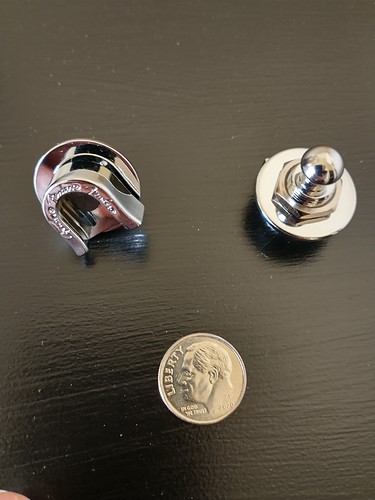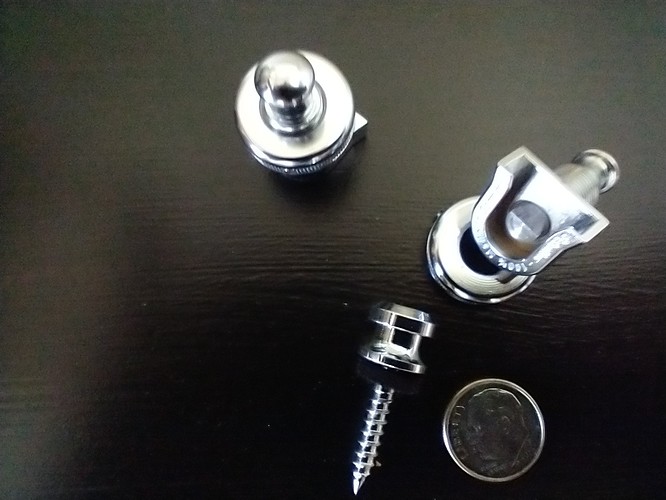I talked about this on another thread yesterday.
You can pack the hole with a toothpick, or shavings off a throw away chop stick, and then screw in the Thinner screw.
The toothpick or chopstick slivers (like string cheese) will act as though you are screwing into a hole that is piloted undersize, and give the screw something to grip on, and you won’t be able to tell the difference.
I have done this on expensive bass bodies and it works wonders.
I’m this close 
Yup, I’ve done the same with straps where the the buttons don’t fit properly. I just put a matchstick in the hole, and then trim it off at the end where it protudes out of the hole, and then screw the button thing in - works like a charm.
While really interesting, your investigation is looking rather expensive for me now haha
That’s what I love about this forum. It’s like a little devil on each shoulder and they’re both egging one another on ![]()
That is a tiny scale application of fixing an ax or hammer handle. When I do things like this, I take the filler piece and give it a little dip in Elmer’s wood glue, or else dropper in a little Elmers 1:1 with water after putting it in (1-3 drops, each visible “normal” size drop is about 40 microliters if you use an eyedropper). The matchstick swells with the water and glue, and then the glue sets it in place and prevents it from shrinking back down. Haven’t done this in a guitar, but it works really well in furniture where there are shear loads on the screw - analogous to a strap pulling sideways on the button.
Yeah, it’s a good method - I use it for various household stuff.
As for egging people on about jazz ultra’s though, I’m not going to comment 
![]()
I didn’t realize that, @Mike_NL . . . but why would Fender sell a set of “American Series” locking strap buttons that don’t fit the strap locks supplied with their “American” Ultra Jazz Bass? ![]()
I examined those buttons and they looked identical to the ones on the Ultra.
I did find a difference between the Ultra locks and the Schaller locks, though. The Fender locks have a plastic tooth instead of a metal one. So I’m going to order a set of Schallers and compare them.
Thanks for your response!
Cheers
Joe
And that’s what really surprised ME, @Paul . . . the Squier does feel the same!
Of course the overall fit and finish, the electronics, and the hardware of the Ultra are superior to anything in the Squier line . . .
But this whole study has greatly increased my admiration for the Squier Vintage Modified and Classic Vibe line of bass guitars, both of which are currently in the $430 range. (I’m sure that their Affinity line would be of lesser quality, though).
Yes, thank you, I am aware of that. ![]() The nickel ones are nice, but I’m going with the chrome ones to match the rest of the hardware.
The nickel ones are nice, but I’m going with the chrome ones to match the rest of the hardware.
Cheers
Joe
Sigh, gak.co.uk will do the ultra on finance…
Noooooooo
Yes, thank you @T_dub and @MC-Canadastan, and @quadfather . . . I have also done repairs in the past with toothpicks and glue . . . 
If it was going to be a permanent replacement of the strap buttons, I would do it that way, but it was only a very brief test, and I replaced the Squier flare type buttons with the original screws.
Thanks for your replies,
Joe
Owning one of those, I really hope so ![]()
LOL that good, huh?
Well, they are playable… Doing a setup is really helpful though.
As to quality, there are some issues like the pickguard being randomly screwed into place as well as other minor faults.
I won’t talk about electronics… Don’t expect much on a bass sold around 200$ 
UPDATE #5: Final Thoughts and Conclusion
After receiving the Schaller-S locks, I compared them to the locks that came with the Ultra bass and found that they fit the strap buttons just fine. Not only that, but they also fit the Fender “American Series” strap buttons (which did not work with those Ultra strap locks). The Schaller locks are of better quality than the Fenders because of the metal vs the plastic tooth, and although it’s a little hard to see in the photos, they also came with black felt pads attached to the screws which are part of the strap buttons:
Fender Strap Locks as supplied with the Ultra:
Schaller Strap Locks purchased separately:
CONCLUSION:
In general, the Squier VM Jazz Bass and the American Ultra Jazz (in passive mode) play the same, feel the same, and sound the same. As I mentioned several days ago, I was surprised that there wasn’t much of a difference between a $400 and an $1800 bass guitar in those regards. I switched back and forth between them several times to verify that.
But once the Ultra is in active mode, it is a clear winner in both volume and tone!
The major improvements of the Ultra over the Squier include:
— 3 band 18v preamp
— switchable active/passive modes
— high mass bridge
— noiseless pickups
— compound radius and satin finish neck
— 21 frets (providing 4 octaves E1 to E4)
— sculpted neck heel
Add to that the more aesthetically pleasing “special” color, better detailing with the white binding along the neck, fancier-looking tuner keys, the tool pouch, hardshell case, and the above mentioned strap locks.
For a ~$400 bass guitar though, the Squier is hard to beat. I would definitely recommend it to anyone from a beginner to an advanced player. (Don’t forget our Trusty Bass Teacher uses his regularly in videos and in lessons! ![]() ). It can also be upgraded with any number of parts, and I may try doing that at a later date.
). It can also be upgraded with any number of parts, and I may try doing that at a later date.
Minutiae: As I had also mentioned, after playing the Ultra for 10-11 days and then switching back to the Squier, I was just able to detect some differences in the neck. Lots of people do not like a glossy neck vs a satin finish, but I had no real preference one way or the other. (Then again, I haven’t played outdoors on a hot day either). I do think that the “Modern D” shaped neck felt more comfortable than the C neck on the Squier, and the sculpted neck heel is slightly better at allowing better upper fret access than the block-shaped heel found on the Squier. One very minor complaint I have about the Ultra is the location of the cable jack along the bottom edge of the body vs the control plate on the Squier, but this is because of the preamp. YMMV in any of these regards.
However, the burning question still remains:
“Is the Ultra really worth four to five times the cost of the Squier?”
It’s my position that Fender has farmed out construction to foreign manufacturers to save on labor costs, increase profits, and yet still be able to offer a low enough price point to attract buyers. So, American labor costs are the chief reason for the higher price, but it is generally agreed that the quality of the American product is higher. @JT has brought up a number of excellent points about pricing in the Fender Custom Shop - #2 by JT topic, and I won’t go into them here, but it’s definitely worth a read.
Touché, John . . . ![]()
This is true, but the American Ultra Jazz Bass has been a bucket list item for me, and I’m fortunate enough to be able to afford it. I’m also very happy with it. Unless you have fairly deep pockets, I would advise giving it a lot of thought, and trying it out in person, before purchasing one yourself.
Thanks to everyone for following this topic . . . I hope it may be of value to others.
Cheers
Joe
Great summation and happy you are loving the purchase!
On the Squire neck, I am now seriously considering having the gloss finished removed. Talked to my local luthier about it this week. I am truest loving the bass with all its upgrades and blackness, but certainly really liked it in original form too. I am getting very partial to matte finish necks in general so might just do this one last touch after the new tuners arrive.
Enjoy that bass!
Thanks, John @John_E . . . I believe that @howard has dealt with that issue himself by lightly sanding the neck. If you do a search you may find that post . . . ![]()
Cheers
Joe
10 minutes with fine (800 - 1000 grit) sandpaper and you have your matte finish neck. I’ve done it to all of my basses and have no regrets.
Just be sure that it’s what you want - going back to a glossy finish is a whole lot more complicated. 
on it! Been watching some videos on techniques and for sure easy enough to do on my own. Thanks!
Do you sand side to side or up/down neck?
I see folks doing it each way and swearing by it.
@John_E I always sand up/down the neck - it never occurred to me to do it any other way.
Actually, with properly fine grit sandpaper I don’t think it makes a whole lot of difference.


